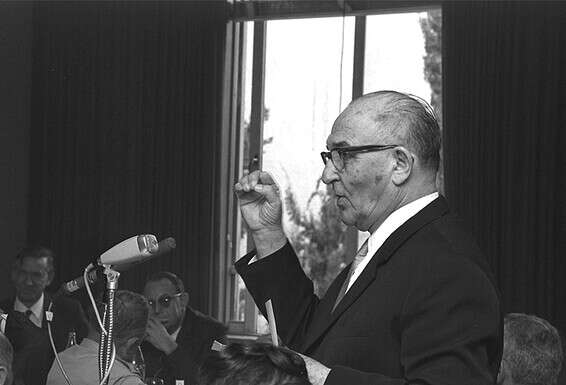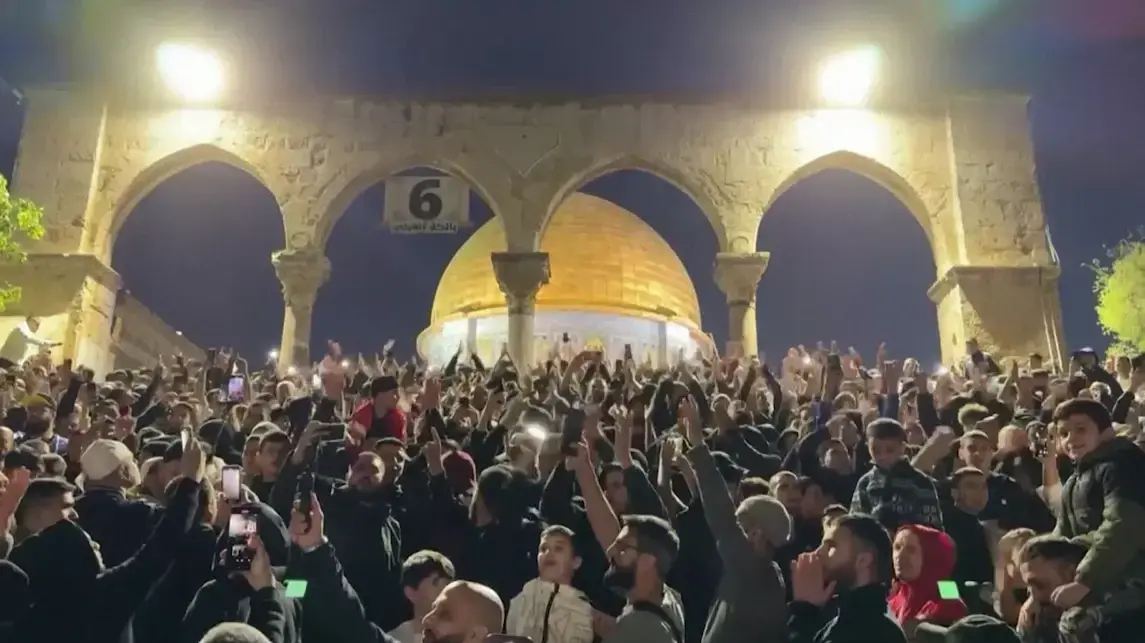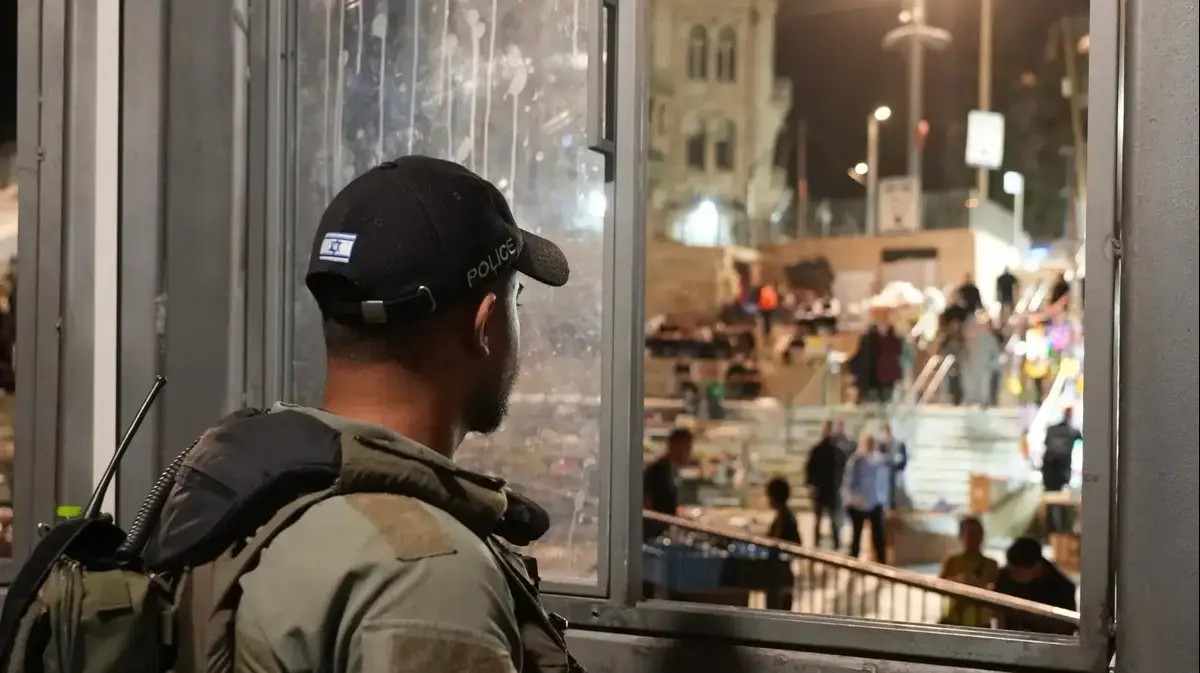We were there already • In 1967, the feeling of "now or never" prevailed • Those unity government ministers also did not know the map and were instructed not to use the term "annexation"
The Dome of the Rock on the Temple Mount
Photo:
// Photo: Moshe Shay
"The mood was as uplifting as at a country fair," Miron Benvenashi, deputy mayor of Jerusalem's Teddy Kollek, described the sights on the streets of United Jerusalem after 1967. "Jews and Arabs spoke in Arabic, in English and in gestures." Just after the walls in the promiscuous areas were overthrown, "the human touch was polite, slightly shy, hostile.
During those times when - as poet Haim Guri - "a hundred megatons of anticipation and longing exploded before our eyes," ministers of the "national Likud government" (so the pre-war unity government was called) hectic discussions about fixing the law of the new facts created in the field . They saw a window of opportunity before them that would soon be closed. "In Jerusalem," "our ambassador" to UN Gideon Rafael described those hours from his perspective, "there is an atmosphere of now or never."
The two mental states described in Nabshanthi and Raphael led a few days later to the historic decision of the Eshkol government, to unify the two parts of Jerusalem, to apply Israeli sovereignty to East Jerusalem and to significantly increase the area of the city.
Like today, on the eve of the decision to apply Israeli sovereignty in the Jordan Valley and Jewish communities in Judea and Samaria - even those days, some 53 years ago - the Israeli government made sure not to call the decision "annexation." The strict legal terminology was "applying the law, administration and jurisdiction of the State of Israel" to the territories of East Jerusalem.
That strictness, then, as these days were, had explanatory, but also substantive reasons: annexation, the National Likud government's ministers explained in 1967, meant taking territory that was not yours, an act prohibited by international law. Unlike Jordan, which annexed East Jerusalem in 1950 (a move recognized by only three states), we "apply Israeli law, administration and jurisdiction" to the territories of East Jerusalem, which we seized for self-defense, after being attacked by those territories.
Levi Eshkol // Photo: GPO
The two resolutions, which are likely to be made by the Likud-led government in blue in more than a month, and then made by the Mapai and Gahal government (Liberal bloc), are similar but also different, and undoubtedly historical and forward-looking .
Demographic Bible
Here are the numbers first: now on the agenda - applying sovereignty to 50% of Area C, which is a million and 750,000 dunams - about 30% of Judea and Samaria. Within this area, the built-up area of the settlements now extends over 1.5% of the land area (87,000 dunams), with the total jurisdiction of the settlements reaching 537,000 dunams, slightly less than a third of the area planned to be annexed. Most of the annexed area is in the Jordan Valley. Which is sparsely settled and is defined as Israel's eastern security zone.
53 years ago, the numbers were much more modest: Israel applied sovereignty to only 70,000 dunams, considered and still considered as high quality - the expanded Jerusalem area - where the Old City and holy places - the heart of the national and religious conflict between us and the Palestinians.
Despite the huge size gap, this time - according to Prime Minister Netanyahu's statements - the sovereignty will not be applied to the Arabs living in Area C, and villages like Ojah in the valley will not be included on the map. They will remain Palestinian enclaves in Israeli sovereignty territory. In 1967, Israel It applied its sovereignty without detours and added about 65,000 Arab residents to Jerusalem, which over the past year turned 350,000 and reduced the Jewish majority in the capital from about 74% to only 60% today, so the law was applied to areas where only an Arab population lived. Today, these are areas where the Jewish population lives, about half a million inhabitants.
It is unclear whether Netanyahu will bring the decision to apply sovereignty only to the government or to the Knesset, as was done in 1967 // Photo: Dudi Vaaknin
The Bible of Israeli policy on the question of "annexation" and its borders, as early as 1967, was more or less: a minimum of Arabs and a maximum of territory. The Bible of American policy on the question of annexation and its borders adopts Israel's demographic perspective, but states that 70% The Palestinians will be left out of the territory for the benefit of their future state.
Dr. Amnon Ramon of the Jerusalem Institute for Policy Research, author of the book "Residents, Not Citizens" (published by the Institute), who researched the annexation process in 1967, notes that at least so far, military and security officials are involved in determining the sovereignty map Only minimal.
Many, he said, even oppose the move, while in 1967 the military rank was very dominant in the map drawing. He then led the planning within the IDF General Staff, Gen. Rehoboam Ze'evi and from the government - Defense Minister Moshe Dayan. Today, the maps are drafted by Prime Minister Ronen Peretz and US Ambassador to Israel David Friedman. In 1967, Secretary Ramon said, the decision was much more consensual than it is today. "It was, after all, the apparently divided Jerusalem, the Wall, and the Old City that we returned to."
Another notable difference, which Ramon also seeks to address, is that the application of sovereignty this time skips the Arab population in the "annexed" area and in fact leaves them as enclaves within Israeli territory.
Ramon remarks that "National Liberal government's Gahal ministers, led by Menachem Begin, behaved in a different way from a value point of view. They realized that two classes of residents could not be created. The population of East Jerusalem has been granted residency status, which although not a full citizenship, is certainly not being ignored, as it seems, they intend to ignore it today. Begin, "Ramon estimates," would not receive an anti-liberal detour of the kind left in the same cell of Israeli law today, two different classes of population. "
Alongside this notable difference, Ramon finds similarities in the fog of battle that central policymakers, then and now, sprinkle around the essence, maps and expected decision content.
Indeed, attempts to talk with ministers in the government and understand what the map will look like, what the security arrangements will be, how interactions between Arab and Jewish residents will take place, where access ways to Jewish communities will pass, and the extent of Israeli construction will be possible in the areas under which sovereignty will apply. Ministers admit that they simply do not know; That they are indeed in heavy fog.
Uncertainty and expectations
In 1967, too, a similar fog prevailed. The vast majority of ministers reported on the new sovereignty boundaries, just shortly before the decision was taken. Most did not know the area and the map. They did not know, for example, that in their vote they were also joining the Shuafat refugee camp in Jerusalem.
Ramon also finds common lines "in the way that the Netanyahu government, like the Eshkol government at the time, is anxious to strengthen itself before the decision is taken, and builds in the public, or in part of it, a very high expectation of the process of applying sovereignty, in a way that can no longer be followed, and withdrawing." .
Indeed, even in 1967, the public's set of expectations was very high, somewhat similar to the set of expectations of the right and some of the center today. About two weeks before the "annexation" hearings were signed, Minister Yosef Sapir said that he thought "the people have already decided, at least for Jerusalem, that this is a matter for the soul."
Prime Minister Eshkol spoke of a man who, during one of his tours, put his head in his car and said: "If you return part of the area we liberated - I leave the country." Justice Minister Ya'akov Shimshon Shapiro testifies to Uzi Benziman in his book "Jerusalem - a city without a wall," said a friend - "if you bring Jerusalem back, your blood is in your head."
Fog, then and today. Ramon
Is it possible to tap on the legal way in which the move was implemented 53 years ago, even on the way Netanyahu intends to implement it now? Possibly.
In the Eshkol government, there was an argument we may be witnessing this time, between direct and rapid legislation that would set explicit annexation, and only administrative steps. Only four ministers in the Mapai-Gahal government supported swift and immediate legislation: Israel Isaiah, Menachem Begin, Israel Galili and Zarah Verhaftig. Eshkol joined them later and Begin returned. He feared that official annexation of Jerusalem would be interpreted as a concession to Judea and Samaria, preferring the administrative way.
Verhaftig also claimed in Rachel's Tomb to include Rachel's Tomb, which is now known to be included in the sovereignty maps that Americans and Israelis are formulating together. Moshe Haim Shapira contented himself with Mount Scopus, the Old City "and maybe a little more than that." Begin claimed in those days to annex all Judea and Samaria areas. Yigal Alon sought to examine the annexation of the Jordan Valley and Mount Hebron.
The new laws were introduced for the Knesset's approval on June 27, 1967, in a speedy and special procedure. No agenda was passed to the Knesset members. The bills were distributed to them only upon the opening of the hearing. Eshkol and many of his ministers did not participate in the debate, so as not to provoke a wide international echo. The Knesset discussed the laws for two hours. The Constitution Committee discussed them for another hour and a half. A large majority of the members of the House approved them. The next day, the government issued an order setting the boundaries of "annexed" territory.
Jerusalem's jurisdiction has tripled. It included, in addition to the 6,000 acres of Jordanian municipality, land from the jurisdiction of another 28 villages to the north, south and east of the distribution line. A chain of Jewish neighborhoods with some 220,000 Jews is now established on these territories. Everyone was talking about "annexation" of East Jerusalem at the time, but formally and legally, it was not annexation, but a combination of territories. So will probably be this time.
Initially, a law was passed amending the Government and Judicial Order Ordinance, incorporating a clause which states that "the law, jurisdiction and administration of the State shall apply to any territory of the Land of Israel which the Government has prescribed in the decree." Then, in the "Determining the Territories" order - under the same amendment - the government ordered that the territory of the Land of Israel, which is described in the Schedule, be designated in this area as the jurisdiction, jurisdiction and administration of the State.
Only the "addition to the decree" specified the demarcated line of the annexed area, but even the annexation legislation did not mention the name of Jerusalem, not even a hint. The demarcation line, later found out by Miron Benvenisti, was not done by a map but by mentioning imaginary lines between waypoints.
The government made sure to avoid using the term "annexation". The official announcements talk about consolidation or reunification. In a proposal to amend the Government and Justice Order Ordinance, the Law on Amendment of the Municipal Ordinance, which authorized the Interior Minister, in his discretion, to expand the area of a municipal municipality by including the area specified in the decree, was also added.
This twist is all about reducing the "annexation" act in the eyes of the world. Amnon Ramon reveals in his book that on the eve of the Knesset's approval of the law, the Foreign Ministry in Jerusalem issued a circular to all Israeli representatives in the world. They were instructed to suppress East Jerusalem's annexation as much as possible.
The guidelines emphasized that the move should be presented to Jerusalem, not as a political-historical act, but as a practical necessity, as a municipal merger, as an act of voluntary administration of the city. Exactly so, ministers in the government believe, will apply sovereignty this time too. It will be presented as an act designed to apply Israeli law to areas where Jews have been mostly Jewish for more than a century, and to comply with the laws of the State of Israel, as appropriate.
And another notable difference: This time, at least until the US election, he stood behind Netanyahu and his moves to apply sovereignty (under the terms of the century plan) to the Trump administration. In 1967, the US was against the move, but let Israel understand that it would not torpedo it.
The UN delegation objected
This July, opposition from most countries in the world and the European Union is expected to apply sovereignty. In 1967, Ramon was impressed by his research, the discussion was under the concern of combined US-Soviet pressure, such as the one that forced Israel to withdraw from the Sinai Peninsula after a holy operation. The ministers, Ramon says, were then subject not only to international pressure, but also to the pressure of the Israeli delegation to the UN - nine delegates, led by Foreign Minister Abba Eban, UN Ambassador Gideon Raphael and six Knesset members who represented most of the House factions.
All members of this delegation voted unanimously to reject the "annexation" laws, but Eshkol then feared shame, after the media had already been invited to survey the Knesset meeting where the annexation measures were to be adopted. To overcome the fears of his ministers, Eshkol initiated a conversation with Foreign Minister Aba Stone in New York. He heard from him that the Knesset's decision to approve the law would be a blow "but we will know how to deal". Thus, in these words, Eshkol convinced his ministers to vote for the move.
53 years later, it is unclear whether Netanyahu will bring the decision to apply sovereignty only to the government or to the Knesset, as was done in 1967. The government has a majority in the move. In the Knesset, the majority will probably be larger, and the right-wing Israel and Israel are also expected to vote in favor.
Meanwhile, it turns out - at least according to some reports - that the United States has toughened its demands on Israel for the application of sovereignty. Members of the Yesha Council have spoken to ministers, confirming a report by journalist Haggai Huberman from last week, according to which the US demands that Israel decide that its borders should be demarcated. The 30 percent of the West Bank will be defined as a definite border, and Israel will be asked to state in advance that it will waive its future requirements for Area C over which sovereignty will not be applied.
Political officials in Jerusalem say the discussions between Israel and the US are not over yet. They suggest not to jump to too hasty conclusions, and wait patiently until the final map is drawn and the final version of the move is drawn up for government approval.









